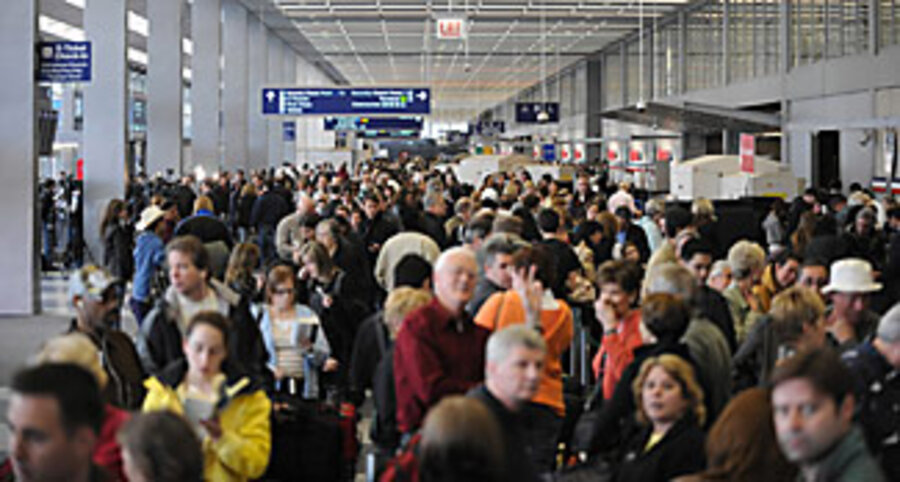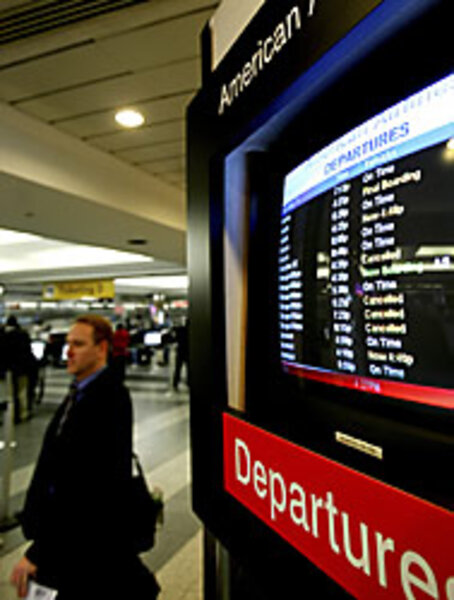Could flight disruptions have been avoided?
Loading...
| New York
In the middle of the game, the goal posts moved.
That's how aviation analysts are explaining last week's stunning move by the Federal Aviation Administration that prompted the grounding of all American Airlines' MD-80 jets – the workhorse of that airline. Delta, United, and other airlines also had to ground all their MD-80s.
The result was more than 3,000 flights canceled, an estimated 300,000 passengers delayed or rerouted, tens of millions of dollars in excess costs to the airlines, and many times that to the economy in lost productivity and wages.
The problem was not an imminent safety threat, according to the airlines, but a technical matter of whether wiring bundles in the wheel wells were wrapped and attached as the FAA had specified.
And that's where the rules of And that's where the rules of the game changed. In the past, say airline officials and aviation analysts, the FAA has negotiated time frames – say, two months – for airlines to come into technical compliance with its directives. But recent whistle-blower testimony indicating that the FAA had become too close to the airlines, and thus lax in its oversight, created a new environment.
"The FAA was not in the mood to negotiate anything, just having had its head handed to it by an oversight committee," says aviation consultant Robert Mann of R.W. Mann & Co. in Port Washington, N.Y. "The FAA moved the goal posts and put the airline in an untenable position: flying knowing it was not in compliance and risk huge fines or loss of its license, or [ground its fleet]."
By late Saturday, the FAA had given all of American's MD-80s clearance to fly and the airline has returned to its regular schedule. American's CEO Gerard Arpey "profoundly apologized" to travelers for the inconvenience. But he didn't have much to say about the FAA. At a press conference Thursday, Mr. Arpey simply said that American was "not successful" in its request for more time to address the technical issues, despite the fact that extra time was something that "often happened in the past."
Did FAA overreact?
The FAA decision not to give American more time to come into compliance has led some aviation analysts to suggest that the agency overreacted as a result of political pressure stemming from the recent revelations in Congress. In hearings at the Transportation Committee, frontline FAA inspectors testified they were ignored by superiors, and some were even threatened, when they raised safety issues at Southwest Airlines.
"The FAA didn't need to ground all of those planes, they could have done it on a rotating basis," says Richard Gritta, an aviation economist at the University of Portland. "But they've been asleep at the switch – in bed with the industry, now they're trying to prove they're really a tiger with teeth and I don't buy it."
The "overreaction" raises questions about the priorities at the FAA, say other analysts. "We do have an extremely safe airline system in this country, but if you look at where we can best use our resources to make it safer, this is probably not it," says Richard Golaszewski, executive vice president of GRA Inc., aviation consultants in Jenkintown, Pa.
The tens of millions of dollars the grounding cost American and the public would have been better spent improving the air traffic control system, says Mr. Golaszewski, or in making safety monitoring systems more efficient. "There was a relatively large social cost [to these groundings]," he says. "This was hard on the traveling public: it seems like they're being punished because the political pendulum [at the FAA] is swinging the other way."
After the 1996 ValuJet crash, the FAA changed the way it regulated the airlines from a primarily tough enforcement-only approach to a more cooperative one. The idea was that if airlines could self-report problems without fear of incrimination, the FAA would be able to collect safety data and prevent problems before they occur. In general, aviation analysts contend this is a solid, premptive approach that allows safety to be addressed systematically. But many also contend that since the 9/11 terrorist attack, which ushered in unprecedented losses in the aviation industry, the FAA has shifted too far in favor of cooperation. This, they say, has lead to dangerously lax oversight.
At least, until the recent round of inspections that prompted the MD-80 groundings.
What went wrong
The questions the FAA raised about the wiring bundles at American Airlines illustrate the FAA's transition. On Thursday, Arpey noted that back in 2004 American Airlines was the lead carrier to come up with a service bulletin to address the possibility of wires in the wheel chafing, which could, in a worst-case scenario, lead to a fire.
The FAA took that service bulletin and turned it into what is called an "airworthiness directive," which gave all airlines that fly MD-80s 18 months to check and change the way the wiring bundles in the wheel wells were wrapped and secured. Arpey says American's mechanics made the required changes on all of the planes.
But in this most recent round of inspections, which were ordered after the FAA whistle-blowers went to Congress, the FAA contended that American did not fix the problem correctly. American did not disagree. "We found that we weren't in precise compliance with the requirements and we need to be," says Arpey.
American has now hired a consultant to ensure that it will interpret the FAA's airworthiness directives properly in the future. And some aviation analysts do see something good coming from last week's disruptions.
"The disruptions were major, but this was not done in response to a crash," says Clint Oster, an aviation analyst at Indiana University at Bloomington. "This is a case where it was preemptive grounding in response to a maintenance concern and not a crash. So, in some sense, it indicates that we have made some progress."






